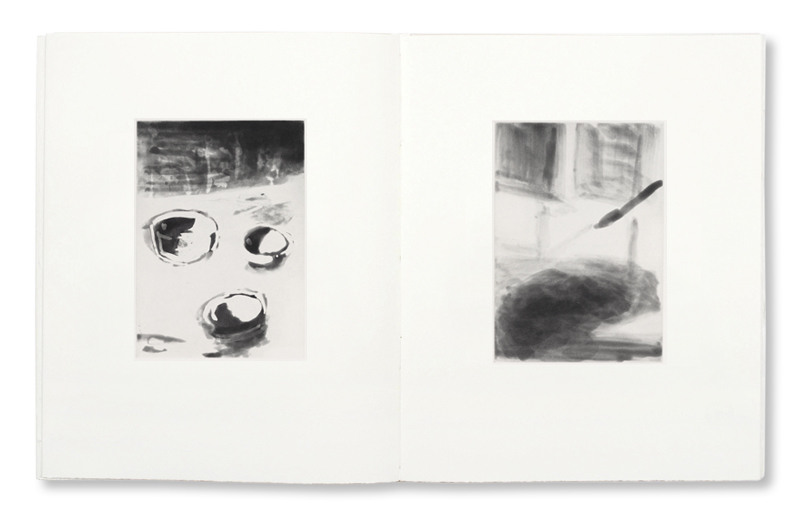Glutnester
2012
With eighteen aquatints/brush etchings, four heliogravures and two tinted monotypes by Heinz Egger,
on Zerkall mould-made paper, 145 g/m², hand-bound, embossed, 39.6 x 32 cm, 44 pages.
The aquatints/brush etchings, heliogravures and monotypes were printed by Michèle Dillier at the Atelier de Gravure,
Moutier, Switzerland. Title and text were printed in letterpress by Romain Crelier in Moutier.
The handmade bindings were produced at the Atelier für Grafik-, Foto- und Schriftgutrestaurierung Michael Rothe,
Bern.
Klaus Merz's poem "Ernstfall" appeared in the anthology "Aus dem Staub", published in 2010 by © Haymonverlag
Innsbruck-Vienna.
Print run of 25 numbered copies. Five additional artist's copies not intended for sale carry the numbers EA I-V.
An edition of aquatints/brush etchings and tinted monotypes was produced in connection
with the artist's book.
We see that it is the image that thrusts itself on this artist; the image, for him, possesses an urgency – it is a place of urgency, as he once declared. As a consequence, it is also a place of forcefulness. Egger uses images to penetrate into issues surrounding reality, surrounding the meaning of things and situations. In this process, uncertainties are the transparency that is characteristic of Egger's intensifications.
Egger is a radical artist, a quietly radical artist. Radical in terms of going back to the roots. Egger's images seek after the roots of appearances, after the reason for that which is. If this tends to make him a dark artist, this in no way implies he is a pessimist. After all, he is aware of the nuances of things. He knows exactly where to shine a light.
Konrad Tobler
Glutnester
2012
With eighteen aquatints/brush etchings, four heliogravures and two tinted monotypes by Heinz Egger,
on Zerkall mould-made paper, 145 g/m², hand-bound, embossed, 39.6 x 32 cm, 44 pages.
The aquatints/brush etchings, heliogravures and monotypes were printed by Michèle Dillier at the Atelier de Gravure,
Moutier, Switzerland. Title and text were printed in letterpress by Romain Crelier in Moutier.
The handmade bindings were produced at the Atelier für Grafik-, Foto- und Schriftgutrestaurierung Michael Rothe,
Bern.
Klaus Merz's poem "Ernstfall" appeared in the anthology "Aus dem Staub", published in 2010 by © Haymonverlag
Innsbruck-Vienna.
Print run of 25 numbered copies. Five additional artist's copies not intended for sale carry the numbers EA I-V.
An edition of aquatints/brush etchings and tinted monotypes was produced in connection
with the artist's book.
Heinz Egger's images radiate fervour. It is the fervour of the images. This world of images is derived from observations
that awaken thoughts, is derived from recollections that, perhaps, also sometimes emerge from dream-cum-reality and from
the unearthly, the unknown. That said, the artist is no dreamer – he is very much in the here and now. The insignificant
can also be put into perspective, emerge from the dark into the light – like the tragic. Where others would narrate, Egger
creates images – by means of painting as well as graphic reproduction, as may be seen in the book Glutnester.
We see that it is the image that thrusts itself on this artist; the image, for him, possesses an urgency – it is a place
of urgency, as he once declared. As a consequence, it is also a place of forcefulness. Egger uses images to penetrate into
issues surrounding reality, surrounding the meaning of things and situations. In this process, uncertainties are the transparency
that is characteristic of Egger's intensifications.
Egger is a radical artist, a quietly radical artist. Radical in terms of going back to the roots. Egger's images seek after
the roots of appearances, after the reason for that which is. If this tends to make him a dark artist, this in no way implies
he is a pessimist. After all, he is aware of the nuances of things. He knows exactly where to shine a light.
Konrad Tobler





